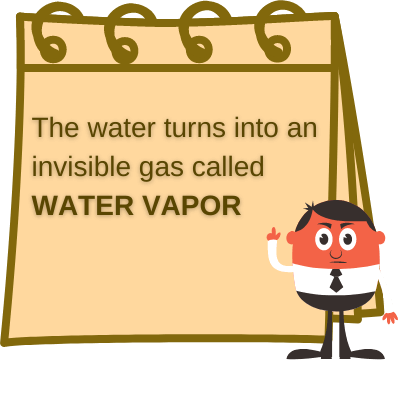The Water Cycle
Let's understand what the water cycle is, how the water cycle works step by step with diagrams, evaporation, condensation, precipitation, and more.

Earth’s water is always moving on, above, and below the surface of the Earth.
This water movement is called the water cycle that supplies all the water needed to support life.
Water is constantly being recycled through the land and the atmosphere. This is called the water cycle or the hydrological cycle.

How the water cycle works?
The water cycle is driven by the sun. It begins when water evaporates into the air. The water cycle consists of:
- EVAPORATION,
- CONDENSATION,
- TRANSPIRATION
- PRECIPITATION
- RUNOFF/COLLECTION.
Evaporation
Evaporation occurs when the sun heats water in oceans, rivers, or lakes and turns it into vapor or steam and rises into the sky. This water vapor collects in the atmosphere in the form of clouds.
The water turns into an invisible gas called water vapor. This water vapor or steam rises and collects into the sky in the form of clouds.

Plants also release water vapors into the atmosphere through TRANSPIRATION or EVAPOTRANSPIRATION. It adds more moisture to the air.
Transpiration is the process by which plants lose water out of their leaves.
Did you know? On a lake such as Lake Conroe, evaporation can cause a water loss of up to 180 million gallons on a hot summer day.
Also Read: Layers of the Atmosphere
Condensation
Condensation is the process of water vapor turning back into liquid water through cooling. It is the reverse of evaporation, where liquid water becomes a vapor.

Precipitation
Runoff or Collection
When water falls back on the ground as precipitation, it gets soaked and funneled into lakes, rivers, or oceans. Water that does not infiltrate the soil is called Runoff.
In simple words, water flowing above the ground is known as Runoff, while the water flowing below the ground is known as Groundwater.
Warm air passes over the ground and the ocean, evaporating water back into the sky again, and the cycle continues.
So you can say that the amount of water on Earth never changes; it just gets cycled again and again through different forms.
Also Read: Why We Have Seasons
In Summary - The Water Cycle Steps
- EVAPORATION – LIQUID (water) > Vapour (gas) through heating. When the sun heats water in oceans, rivers, or lakes and turns it into vapor or steam and rises into the sky. This water vapor collects in the atmosphere in the form of clouds.
- TRANSPIRATION – It happens when plants give off water vapor through their leaves into the air.
- CONDENSATION – GAS or VAPOUR > LIQUID through cooling. When water vapour in the air cools down and turns back into liquid water.
- PRECIPITATION – Precipitation happens when the water droplets get bigger and heavier and start to fall as rain, hail, sleet or snow.
- COLLECTION – When water falls back on the ground as precipitation, it gets soaked and funneled into lakes, rivers, or oceans. WATER RUNOFF, when the water flows over the ground and GROUNDWATER, when water is socked into the ground.
The water cycle is driven by the sun’s energy and by gravity. Warm air passes over the ground and the ocean, evaporating water back into the sky. Gravity makes the moisture fall back to Earth and the cycle continues.

FACT 1. Water is constantly being recycled so we could be drinking the same water Dinosaurs drank millions of years ago.
FACT 2. The infiltration process of the water cycle allows water to enter the surface of the Earth.
FACT 3. The sun powers the entire water cycle process on Earth.
FACT 4. The water cycle converts water into all three different states; liquid (water), solid (ice) and gas (vapor).
FACT 5. Every loaf of bread we eat takes about 570 gallons of water from the Water Cycle.
FACT 6. About 90 percent, of Earth’s ice mass is in Antarctica, while the Greenland ice cap contains 10 percent of the total global ice mass..
FACT 7. According to the National Snow and Ice Data Center (NSIDC), if all glaciers melted today the seas would rise about 230 feet (70 meters). source
FACT 8. Only 3% of the Earth’s water is freshwater. 2% of this freshwater is actively stored in glaciers or ice caps. So, only 1% of water is safe for the living organisms, including humans to consume and use.
FACT 9. The largest glacier in the world is the Lambert-Fisher Glacier in Antarctica.
FACT 10. The water cycle has been working for billions of years.
Now it’s your turn. Attempt the water cycle quiz.
